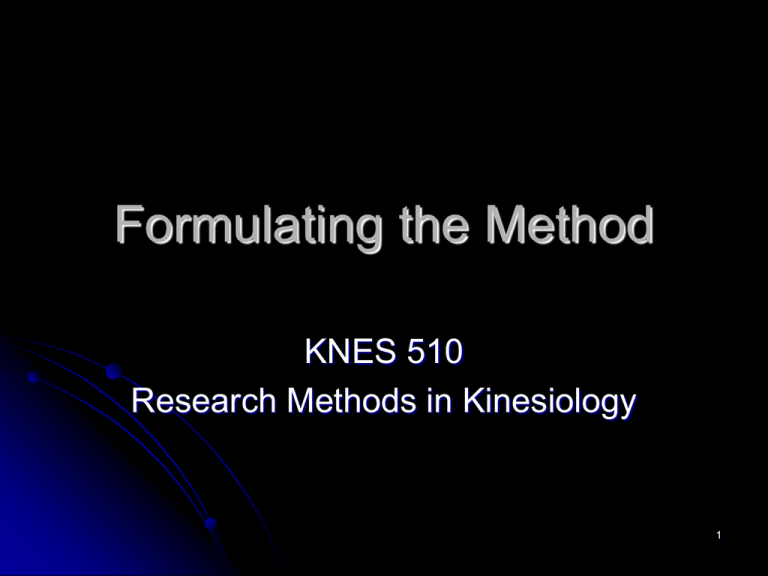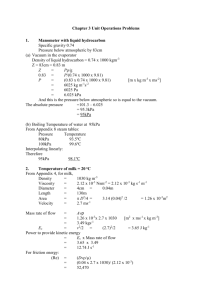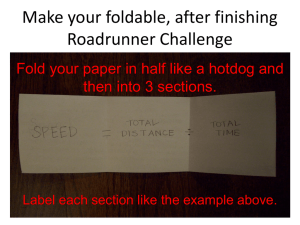
Formulating the Method
KNES 510
Research Methods in Kinesiology
1
Planning the Methods
Parts of the method section
Participants
Instruments or apparatus
Procedures
Design and analysis
Two principles of planning
Less is more.
Simple is better.
2
Describing Participants
Special characteristics: what relates to the
study?
Age, HT, mass and sex
Training level
What to tell about participants
Number
Loss of participants
Protecting participants (see chapter 5)
3
Participants - Proposal
For this study 48 males, ranging in age
from 21 to 34 years, will be randomly
selected from a group (N = 147) of welltrained distance runners (VO2 max = 60
ml/kg/min or higher) who have been
competitive runners for at least 2 years.
Participants will be randomly assigned to
one of four groups (n = 12).
4
Participants - Defense
In this study 48 males, ranging in age from 21 to
34 years, were randomly selected from a group
(N = 147) of well-trained distance runners (VO2
max = 60 ml/kg/min or higher) who had been
competitive runners for at least 2 years. The
participants had the following characteristics
(standard deviations in parentheses): age, 26
years (3.3); height, 172.5 cm (7.5); weight, 66.9
kg (8.7); and VO2 max, 65 ml/kg/min (4.2).
Participants were randomly assigned to one of
four groups (n = 12).
5
Describing Instruments
Questions to consider in selecting
instruments
Validity and reliability
Difficulty of obtaining measures
Access to equipment or tests
Knowing how to use them
What should be presented
Description (including validity and reliability)
Drawing, photograph, sample items
How it is scored
6
Describing Procedures
What will happen
When, where, how much time
Pilot data: can you do this?
Scheme for data acquisition, recording, and
scoring
Planning treatments
How long, how intense, how often
Participant adherence
Pilot data: can participants do this?
Appropriate treatment for participants
7
Avoiding Methodological Faults
Details of the procedures
Specific order of things
Timing of events
Instructions given
Briefings, debriefings, safeguards
Piloting your procedures
Can you do this?
Can participants do this?
Do measures work?
Do treatments work?
8
Example – Methods
Subjects
Thirty adult subjects between the ages of 19
and 29 years of age will volunteer for this
study.
The subjects will be randomly assigned to one
of three groups: 1) control group (n = 10); 2)
slow velocity training group (n = 10); or 3) fast
velocity training group (n = 10).
The study will require two (control group) or
five (slow velocity and fast velocity training
groups) visits, lasting approximately one hour
per visit.
9
Example – Methods, cont’d.
All subjects will be tested on visits 1 and 5,
and the two training groups will train on
visits 2, 3, and 4. There will be 48-72
hours between testing and/or training
sessions.
10
Testing/Training Schedule
11
Example – Methods, cont’d.
Strength Testing
Following a five-minute warm-up, subjects will
perform three maximal, concentric isokinetic
muscle actions of the leg extensors of the
nondominant leg on a Cybex II dynamometer
(Cybex, Inc., Ronkonkoma NY)
The tested velocities will be 30, 150, and
270.s-1.
The order of testing velocities will be
randomized.
The intraclass reliability coefficient for
isokinetic PT is R = 0.959.
12
Example – Methods, cont’d.
Training Protocol
The training groups will perform slow velocity
(30.s-1) or fast velocity (270.s-1) isokinetic leg
extensions.
The subjects in each training group will
perform four sets of 10 maximal muscle
actions at their respective velocities on visits
2, 3, and 4.
13
Example – Methods, cont’d.
Electromyographic Measurements
Three separate bipolar (20 mm center-tocenter) surface electrode (circular 4 mm
diameter Ag-AgCl, Biopac Systems, Inc.,
Santa Barbara, CA) arrangements will be
placed over the longitudinal axes of the
vastus lateralis, rectus femoris, and vastus
medialis muscles.
Intraclass reliability coefficients for
electromyographic measures from the
superficial quadriceps femoris range from R =
0.80 to 0.88.
14
Example – Methods, cont’d.
Mechanomyographic Measurements
The MMG signal will be detected by
accelerometers (Entran, EGAS-FT-10-/V05,
Hampton, VA).
The accelerometers will be placed over the
bellies of the vastus lateralis, rectus femoris,
and vastus medialis muscles between the
active EMG electrodes.
Intraclass reliability of mechanomyographic
signals range from R = 097 to 0.98.
15
16
Example – Methods, cont’d.
Signal Processing
The sampling frequency will be 1000 Hz for all
signals.
The EMG and MMG signals will be bandpass
filtered (fourth-order Butterworth filter) at 5100 Hz and 10-500 Hz, respectively.
17
Example – Methods, cont’d.
The EMG and MMG amplitude and frequency
values will be calculated for a time period that
corresponds to a 50 range of motion from
approximately 110 to 160 of leg flexion (i.e.,
at 30.s-1 the amplitudes and frequencies for
1.67 s of the MMG and EMG signals will be
calculated, at 150.s-1 the amplitudes and
frequencies for 0.33 s will be calculated, and
at 270.s-1 the amplitudes and frequencies for
0.19 s will be calculated) .
18
Example – Methods, cont’d.
Signal Processing, cont’d.
The amplitude of the signals will be expressed
as root mean square (rms) amplitude values.
All frequency analyses will be performed with
custom programs written with Labview
software (version 6.1, National Instruments,
Austin, Texas) and expressed as hertz (Hz).
Frequency data will be expressed as mean
power frequency (MPF).
19
Design and Analysis
Design a study in which
the treatments cause the changes observed
the variables are related with no intervening
variables
20
Design and Analysis, cont’d
Analyzing the data
Correct analysis
Correct interpretation
Establishing cause and effect
Independent variable dependent variable
21
Data Analysis Example
Statistical Analyses
Isokinetic PT data will be analyzed using a 3-way (or
a 3 x 2 x 3) (velocity [30, 150, and 270.s-1] time
[pretraining, posttraining] group [slow velocity, fast
velocity, control]) mixed factorial ANOVA.
EMG and MMG data will be analyzed using 4-way
(muscle [vastus lateralis, rectus femoris, vastus
medialis] velocity [30, 150, and 270.s-1] time
[pretraining, posttraining] group [slow velocity, fast
velocity, control]) mixed factorial ANOVAs.
An a-priori alpha of 0.05 will be considered significant
for all comparisons.
22
Methodological Characteristics
Influence Each Other
Interactions among
participants and measurements
participants and treatments
measurements and treatments
participants, measurements, and treatments
23
Next Class
Midterm Exam
Chapter 19
Write (due the week after midterm):
First draft of methods
First sub-heading of lit review complete
24










